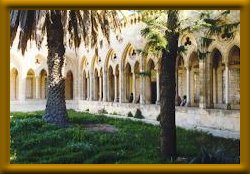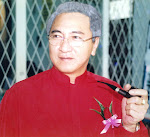
The Lord' Prayer in Kadazan Language in the Church of Pater Noster in Jerusalem.
The Lord’s Prayer (the Our Father) was translated in Kadazan (Tama’ Za) and transcribed on a six-piece of coloured tiles edged with tainted motifs of different colours and designs. I was told by one of the initiators responsible for putting up the plaque in the Church of Pater Noster in Jerusalem after he and his fellow pilgrims came back from their Holy Land pilgrimage in December 1995.
A plaque consisting of six decorated tiled panels is the smallest available size to display the Lord’s Prayer in your own language, and this would cost US1,000.00.
One of the Facebook subscribers wrote to enquire the criteria by which the initiators used to choose the Kadazan dialect in particular as a language translation of the Lord’s Prayer and, for that reason the “Tama’ Za” prayer is now being displayed in the Holy Land.

Church of Pater Noster in Jerusalem
Well, for the benefit of those readers who have yet to visit the Holy Land, let me begin by describing briefly the Pater Noster Church. The church is built on top of a cave on the Mount of Olives, long ago associated with the teachings of Jesus. It's focal point is the cloister, decorated with tiled panels of the Lord's Prayer in 62 languages.
The Church of the Pater Noster remembers Jesus' teaching of the Lord's Prayer to His disciples.

The Lord' Prayer in 62 panels outside the Church
The initiators happened to be Kadazans from Penampang and Papar who were amongst the pilgrims when they visited the Holy Land in December 1995. The Pilgrimage (I was told) was dubbed as “Christmas in the Holy Land’.
The pilgrims, to mention a few, were Clarence Bongkos Malakun, Marcel Leiking, Thasius Joeman, Cladius Roman, Cosmas Abah, Cyril Pinso, Anselmus Dusain, (the late) Cornellius Matunjau, (the late) Charles Jayasuria, Robert Chin, Louis Jalin, George Evaristus and their wives accompanied by Rev. Fr. Dapoz as their spiritual leader.
When they visited the Church of Pater Noster they discovered that it was cloistered with the Lord’s Prayer all of which were written in different languages and dialects on decorated panel tiles embedded on concrete walls. The names of the originating country are conspicuously written on top part of the plague so that visitors can easily identify if one were to look for country’s name.
The initiators then thought it appropriate that, as a mark of remembrance of their visits to the Holy Land, they decided to put up a plaque of the Lord's Prayer in Kadazan dialect. But unfortunately the Church management disallowed it despite the fact that they could afford to pay the requisite sum of US1,000.00 for a 12" by 18" size decorated tile-paneled plaque.
To display a plaque, one has to get the concurrence and approval from the Bishop of their Diocese who will then forward the approved prayer to the church management of Pater Noster.
When they came back from their pilgrimage, the initiators approached His Lordship, the Bishop of Kota Kinabalu Diocese to consider and approve (as required by the authority in Pater Noster's Church) the translation of the Lord's Prayer in Kadazan dialect and thence to forward it to the Holy Land. This was done and the initiators never heard about it since then.
To all intents and purposes, the Lord's Prayer was translated in Kadazan dialect and to be captioned with ‘Sabah’ as the place of its origin. But it was not to be - the plaque was inadvertently captioned as “Kadazan” instead.
Before I left for my pilgrimage in May 2005, that was 10 years later after Datuk Marcel Leiking visited the Holy Land, he specifically told me not to fail to locate the ‘Tama Za” plaque in the Church of Pater Noster.
When we arrived at the Church of Pater Noster, we failed to locate the plaque. We were only able to see the other plaques displayed outside the Church building because it was closed for public viewing on that particular day. We could only manage to see those plaques displayed on the specially constructed concrete walls within the church compound. We left the church with disappointment since we could not find ‘Tama’ Za’ plaque.
Upon our insistence, our guide obliged us to go back to the same Church the following day. This time it was our lucky day that the church was opened for public viewing.
At long last, we managed to find the ‘Tama’ Za’ plaque embedded onto one of the walls within the Church building itself.
Leiking was surprised and bemused when I showed him the photo of the plaque captioned with the word "KADAZAN' instead of the usual name of the country from which the prayer is originated, in this case, either Sabah or Malaysia.
Marcel told me that there might have been a miscommunication between the Diocese of Kota Kinabalu and the Church of Pater Noster with regard to the caption. Or was there a Divine intervention?
Well, as we all know, man proposes, God disposes. In His own mysterious way, God found a place of the word ‘Kadazan’ permanently displayed in the Holy Land!.
Coming back to the enquiry, there was in fact no criteria whatsoever used by the initiators. It so happened that the initiators are Kadazans from Penampang and Papar, who are familiar with the Lord’s Payer in proper Kadazan language and, for this reason, the ‘Tama Za’ prayer found its way to the Holy Land!


.jpg)




No comments:
Post a Comment